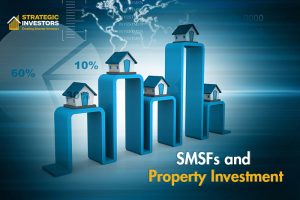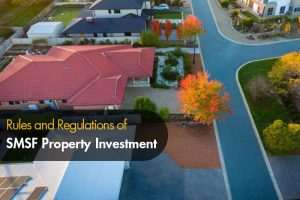
Have you ever dreamed of using your superannuation to invest in property and grow your retirement savings?
With self-managed super funds (SMSFs), this dream can become a reality.
In this comprehensive guide, we will explore the world of SMSF property investment, covering everything from understanding SMSFs and the rules and regulations, to financing and managing your investment. Let’s dive in and unlock the potential of buying property with super!
Key Takeaways
- Understand SMSFs and property investment types to ensure successful investments.
- Adhere to rules and regulations, including the sole purpose test, purchasing restrictions, financing requirements & tax implications for rental income & capital gains.
- Seek professional advice from financial advisors, accountants & legal counsel to maximize returns while minimizing taxation.
Understanding SMSFs and Property Investment
 SMSFs offer a unique opportunity for individuals to take control of their superannuation and invest in property for retirement. As property investors, SMSF members can choose between residential and commercial properties as investment options, each with their own set of rules and regulations.
SMSFs offer a unique opportunity for individuals to take control of their superannuation and invest in property for retirement. As property investors, SMSF members can choose between residential and commercial properties as investment options, each with their own set of rules and regulations.
Grasping these investment types and their integration into an SMSF is key for a successful investment strategy.
What is an SMSF?
A self-managed super fund (SMSF) is a private superannuation fund that allows members to manage their own investments, including property. The primary objective of an SMSF is to give members increased control over their superannuation, empowering them to make their own investment decisions.
One key difference between an SMSF and other types of super funds is that the members are also the SMSF trustees, enabling them to manage the fund for their own benefit, such as deciding to buy property. As SMSF trustees, they are responsible for ensuring compliance with super and tax laws.
How SMSFs can invest in property
Self-managed super funds are permitted to invest in both residential and commercial property, as long as they adhere to all applicable regulations and guidelines. For example, an SMSF may invest up to 100% of its funds into commercial premises if a member of the fund is operating a business, considering the property value and other factors.
However, certain restrictions apply when investing in residential property, such as the prohibition of purchasing property from related parties, including fund members or their relatives. Additionally, it is not permissible for any trustee or their relations to rent or inhabit residential property held in an SMSF.
The Rules and Regulations of SMSF Property Investment
 Adhering to the sole purpose test and purchasing restrictions is fundamental for fruitful property investment through an SMSF. Failing to adhere to these regulations can lead to sanctions or forfeiture of tax concessions.
Adhering to the sole purpose test and purchasing restrictions is fundamental for fruitful property investment through an SMSF. Failing to adhere to these regulations can lead to sanctions or forfeiture of tax concessions.
It is the duty of all trustees to be accountable for any choices made by the fund, regardless of whether they enlist the help of an external party, or another member/trustee makes a determination.
Sole Purpose Test
The sole purpose test is a requisite for all regulated superannuation funds, including SMSFs. It guarantees that each investment made or action taken by the fund is solely for the purpose of solely providing retirement benefits to members or their dependents.
The Australian Taxation Office (ATO) applies the sole purpose test when assessing the compliance of an SMSF, reviewing the fund’s investments and activities to ensure they align with the sole purpose of providing retirement benefits. Failure to fulfill the sole purpose test can result in penalties, and trustees may be held accountable for any losses incurred.
Purchasing Restrictions
In addition to the sole purpose test, SMSFs must also adhere to purchasing restrictions when investing in property. It is not permissible for SMSFs to purchase property from related parties, such as fund members or their relatives.
Additionally, the SMSF must be maintained for the primary purpose of providing retirement benefits to the members, meaning that fund members or any of their relatives cannot reside in or rent the property. Abiding by these restrictions is vital to dodge penalties and secure the success of your SMSF property investment.
Financing Your SMSF Property Investment
 Navigating the finance process for an SMSF property investment can be intricate, especially when considering a limited recourse borrowing arrangement and meeting specific loan criteria when you need to borrow money for loan repayments.
Navigating the finance process for an SMSF property investment can be intricate, especially when considering a limited recourse borrowing arrangement and meeting specific loan criteria when you need to borrow money for loan repayments.
LRBAs allow SMSFs to borrow funds for property investment under strict conditions, while loan requirements and criteria differ from traditional property loans, often resulting in higher costs and stricter rules.
Limited Recourse Borrowing Arrangements (LRBAs)
An LRBA is a unique borrowing arrangement that permits a SMSF trustee to acquire funds from a third-party lender to purchase a property. This arrangement involves the establishment of a separate property trust and trustee on behalf of the super fund, which holds the property outside the actual SMSF structure.
The purpose of such an arrangement is to limit the recourse of the lender, meaning that in the event of default, the lender can only make a claim on the property and not on the SMSF’s other assets.
Loan Requirements and Criteria
SMSF loans have different requirements and higher costs compared to traditional property loans. Most financial institutions require a minimum balance of $200,000 for SMSF loans, and the borrowing criteria are generally stricter.
Engaging a licensed financial adviser to unveil the risks linked with SMSF property investment, including borrowing and leveraging, proves beneficial. Taking the time to understand the loan requirements and criteria can help ensure a successful SMSF property investment.
Tax Considerations for SMSF Property Investors
 Investing in property through an SMSF comes with tax implications, including rental income taxation and capital gains tax liability.
Investing in property through an SMSF comes with tax implications, including rental income taxation and capital gains tax liability.
Comprehending these tax implications and their influence on your investment is key to maximizing returns and diminishing tax liabilities.
Rental Income Taxation
The rental income generated from an SMSF property is subject to a tax rate of 15%. Additionally, interest payments on loans taken out to acquire the property are eligible for tax deductions.
Being cognizant of these tax implications and planning accordingly is necessary for property investors to keep their investment profitable and in line with taxation laws.
Capital Gains Tax Liability
Capital gains tax is a tax on the profit derived from the sale of an asset, such as an investment property. The capital gains tax liability for SMSF property investments is generally taxed at a concessional rate of 15% while the SMSF is in the accumulation phase. However, if the investment is held for longer than 12 months, an SMSF may be entitled to a discount of one-third on the capital gains tax.
The SMSF is in pension phase and the sale of a property that has been owned for more than 12 months will attract a 10% capital gains tax. This applies regardless of the duration of ownership..
Comprehending these tax liabilities aids in making informed decisions regarding your SMSF property investment.
Managing and Maintaining Your SMSF Property Investment
 Managing and maintaining your SMSF property investment involves finding tenants, collecting rent, and maintaining the property. It is the responsibility of the SMSF trustee to oversee these tasks, ensuring the property remains a profitable investment and adheres to the relevant rules and regulations.
Managing and maintaining your SMSF property investment involves finding tenants, collecting rent, and maintaining the property. It is the responsibility of the SMSF trustee to oversee these tasks, ensuring the property remains a profitable investment and adheres to the relevant rules and regulations.
Finding Tenants and Collecting Rent
As an SMSF trustee, you are responsible for finding tenants, collecting rent, and ensuring lease agreements comply with regulations. This involves advertising the property, screening potential tenants, and negotiating lease agreements that align with the applicable laws and regulations, including the Superannuation Industry (Supervision) Act 1993 and the Corporations Act 2001.
Timely rent collection and maintaining precise records of all rent payments are also vital responsibilities of SMSF trustees.
Property Expenses and Maintenance
Property expenses, such as rates, insurance, and repairs, must be met from the SMSF. Maintenance tasks, including painting, gardening, and general upkeep, must also be managed and paid for by the SMSF.
When it comes to major renovations or improvements, these must be financed by the existing cash held within the super fund and not by the loan or borrowed funds. Appropriate administration of property expenses and maintenance is necessary for the successful outcome of your SMSF property investment.
The Importance of Professional Advice
 Professional advice from financial advisors, accountants, and legal counsel is indispensable for successful SMSF property investment. These professionals can help with:
Professional advice from financial advisors, accountants, and legal counsel is indispensable for successful SMSF property investment. These professionals can help with:
- Navigating the complex regulations
- Ensuring compliance with SMSF property investment rules
- Providing guidance on property purchasing, leasing agreements, and tax implications.
They can also help identify potential risks and opportunities, and provide advice on the best strategies for
Financial Advisors and Accountants
 Financial advisors and accountants can help SMSF property investors by:
Financial advisors and accountants can help SMSF property investors by:
- Navigating the complex regulations and ensuring compliance with investment rules
- Providing advice on developing a tailored investing plan
- Examining specified assets
- Comprehending rules and regulations
Securing professional counsel while investing in property through an SMSF is crucial to comply with the pertinent rules and regulations and to affirm that the investment suits the investor’s individual circumstances.
Legal Counsel
Legal counsel can provide the following services for SMSFs and related tax matters:
- Practical, thorough, and commercially-realistic advice
- Advice on federal and state tax issues pertinent to SMSF property investments
- Guidance on property purchasing and leasing agreements
- Ensuring compliance with relevant laws
Legal counsel consultation can assist in structuring your SMSF property investment correctly and ensures adherence to all applicable laws and regulations.
Summary
In conclusion, SMSF property investment offers a unique opportunity for individuals to take control of their superannuation and invest in property for retirement. By understanding the rules and regulations, financing options, tax implications, and seeking professional advice, you can successfully navigate the complexities of SMSF property investment and grow your retirement savings. Are you ready to unlock the potential of your super?
Frequently Asked Questions

How much deposit do you need to buy property in super?
To purchase a property for your SMSF, you need to set aside 20-25% of the property value as a deposit and an additional 5% to cover other fees and charges like stamp duty.
How much can my super fund borrow to buy property?
SMSFs can borrow up to 80% of the property value for a loan term of up to 30 years, with up to five years of interest-only repayments. The minimum loan amount is $50,000 and there is no set maximum, subject to approval by the lender and the borrowing capacity of the fund.
Can I buy a property with my super and live in it?
Unfortunately, you are unable to purchase a property through your super and live in it. You can only use your superannuation to buy your first home if you have met the relevant superannuation condition of release.
Can self-managed super fund invest in property?
Yes, self-managed super funds can invest in property. It can be done either by having the funds to purchase it outright, or taking out a loan to purchase an investment property as part of a retirement strategy. This can be a great way to diversify your retirement portfolio and potentially increase your returns. However, it is important to understand the risks associated with investing
What is the sole purpose test for SMSF property investment?
The sole purpose test is an important measure that ensures that SMSF investments are only made for the primary purpose of providing retirement benefits to the members.













